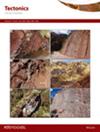意大利南阿尔卑斯山东部的构造演化:从新的构造数据和地质年代约束重新评估
IF 3.6
1区 地球科学
Q1 GEOCHEMISTRY & GEOPHYSICS
引用次数: 0
摘要
南阿尔卑斯山东部褶皱-推覆带(ESA)是欧洲阿尔卑斯山地震活跃的 S 向后缘的一部分。迄今为止,其在大陆缩短过程中的时间构造演化一直受到很少且分辨率较低的间接时间约束。为了更好地阐明欧空局的时空演化,我们从两个区域推力系统收集了新的构造和地质年代数据:最内侧的南向瓦卢加纳推力系统(VT)和更外侧的贝鲁诺推力系统(BTS)。野外工作使我们能够确定这些推力和相关褶皱的几何和运动学特征,并为我们从与 VT 和 BTS 结构相关的代表性样本中进行断层冲沟 K-Ar 和构造碳酸盐 U-Pb 测年的取样策略提供了依据。我们的研究结果表明,VT 在晚白垩世(78 ∼ 76 Ma 之间)就已经因远场应力而开始活跃,其反复重新活跃一直持续到晚中新世(6 Ma ∼ 6 Ma)。BTS在渐新世(30 Ma)和渐新世-中新世边界(23 Ma)记录了两次不同的变形事件。VT活跃了72 Myr,部分作用于序外推力。根据区域相关性,我们提出欧空局与更西边的南阿尔卑斯山中部有着相似的时空变形历史。我们提出了一个概念性的区域构造模型,即在整个南阿尔卑斯山漫长的造山运动变形过程中,发生了多次大体共时的变形事件,以应对总体上持续的西北-东南向缩短。本文章由计算机程序翻译,如有差异,请以英文原文为准。
Tectonic Evolution of the Eastern Southern Alps (Italy): A Reappraisal From New Structural Data and Geochronological Constraints
The Eastern Southern Alps fold-and-thrust belt (ESA) is part of the seismically active S-verging retro-wedge of the European Alps. Its temporal tectonic evolution during continental shortening has so far been constrained by few and low-resolution indirect time constraints. Aiming at better elucidating the ESA spatiotemporal evolution, we gathered new structural and geochronological data from two regional thrust systems: the innermost south verging Valsugana Thrust (VT) and the more external Belluno Thrust System (BTS). Field work allowed us to constrain the geometry and kinematics of those thrusts and related folds and informed our sampling strategy to carry out fault gouge K-Ar and tectonic carbonate U-Pb dating from representative samples structurally associated with the VT and BTS. Our results suggest that the VT was active already in the Late Cretaceous (between ∼78 and 76 Ma) in response to far-field stresses, with repeated reactivation continuing to the Late Miocene (∼6 Ma). The BTS recorded two distinct deformation events during the Oligocene (∼30 Ma) and at the Oligocene-Miocene boundary (∼23 Ma). The VT was active for ∼72 Myr and partly acted during out-of-sequence thrusting. Based on regional correlations, we propose that the ESA share a similar spatiotemporal deformation history with the central Southern Alps farther to the west. We suggest a conceptual regional tectonic model wherein multiple, broadly coeval deformation events occurred in the entire Southern Alps during their long-lived orogenic deformation in response to generally continuous NW-SE shortening.
求助全文
通过发布文献求助,成功后即可免费获取论文全文。
去求助
来源期刊

Tectonics
地学-地球化学与地球物理
CiteScore
7.70
自引率
9.50%
发文量
151
审稿时长
3 months
期刊介绍:
Tectonics (TECT) presents original scientific contributions that describe and explain the evolution, structure, and deformation of Earth¹s lithosphere. Contributions are welcome from any relevant area of research, including field, laboratory, petrological, geochemical, geochronological, geophysical, remote-sensing, and modeling studies. Multidisciplinary studies are particularly encouraged. Tectonics welcomes studies across the range of geologic time.
 求助内容:
求助内容: 应助结果提醒方式:
应助结果提醒方式:


